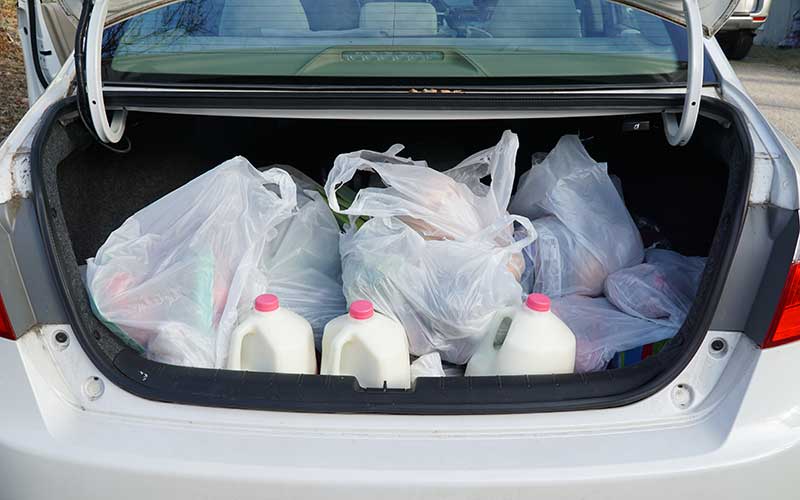
Banning single-use plastic bags is a small but critical first step towards tackling the plastic crisis. Photo: ND700 via Shutterstock
Updated on June 16, 2020
At the outset of efforts to combat the plastic pollution crisis, local and state governments across the U.S. are focused on banning single-use plastic bags. CLF is also committed to passing bag bans in each New England state and has covered the many reasons why plastic bags should be outlawed in previous blogs.
As these efforts gain headway, however, several studies have emerged challenging the effectiveness of bag bans. These studies – and their coverage in the media – are causing some confusion among consumers and legislators.
We want to set the record straight since studies critiquing plastic bag bans don’t account for the broader scope of plastics – and they shouldn’t be taken as an excuse not to ban bags at all.
Plastic Bags’ Carbon Footprint and Toxicity – Both Matter
The list of studies and reports on the dangers of plastic seems to get longer by the day – our plastic problem clearly has become a crisis. The production, use, and disposal of plastic are all bad for human health and the environment, as plastic is rarely recycled or even recyclable. According to National Geographic, if the plastics industry were a country, it’d be the fourth largest carbon emitter after China, the U.S., and India.
Still, some argue that plastic grocery bags are not part of the carbon problem. The Environment Agency in the U.K. released a report in 2011 that shows the carbon impact of paper, reusable plastic, and cotton bags is higher than single-use plastic bags when considering the production, use, and disposal of each. According to the report, a cotton bag would need to be used 131 times to have a lower effect on the climate.
What this report doesn’t include is any attempt to calculate the toxicity of plastic or the dangers of littering plastic bags. Surely its conclusion would be different were it to factor in:
- the impacts of plastic production, such as the cancerous toxins unleashed by manufacturing plants on low-income and communities of color in Louisiana and western Pennsylvania,
- the deadly burden of plastic bags on marine animals, such as whales and sea turtles,
- or the toxic fumes released by waste incinerators when plastic is burned.
What’s more, when fees on paper bags are included in single-use plastic bag bans, consumers are more likely to bring reusable bags. A cotton bag can be used thousands of times, and you can even compost it once you’re done with it. When taking all of this into account, the report’s sole focus on carbon analysis is deceptive because using plastic is always more toxic and polluting than the alternatives.
Bans aren’t Perfect, But They Still Work
A more recent study from a researcher at the University of Sydney found that California’s bag ban led to a moderate increase in paper bag usage and pushed some customers to buy thicker plastic bags. The study suggests these thicker bags were purchased to replace the secondary use of free, single-use plastic bags as trashcan liners or to pick up pet waste. As a comparison of weight, the study reported that 28.5% of the plastic reduced through a bag ban was offset by shifting consumption to other bags.
The upshot of the Sydney study is that the California bag ban reduced plastic bag consumption by 71.5% – a huge decrease. It also took 100% of those plastic grocery bags out of the recycling system, where they bound up machinery and increased costs. The ban also kept them from littering neighborhoods and the environment.
While the Sydney study is cited as a criticism of bag bans, it also shows how successful they are in reducing plastic bag use. The study also indicates that bans don’t go far enough to end the plastic crisis.
Bag Bans are the Starting Line, Not the End Goal
Plastic is always the wrong option. It pollutes and is toxic throughout its production and use. What’s more, it poses a deadly threat to marine and land-based life and must always be burned or buried, even after being recycled a few times. Although bag bans won’t solve the plastic crisis on their own, they do help to change plastic consumption habits and cause consumers and retailers to be more open to alternatives.
That’s why CLF’s Zero Waste Project is focused on passing bag bans, while also working to reduce plastic use overall – including any single-use plastics designed for disposal. Our Plastic Free New England campaign embodies that effort – to move towards a New England with no disposable plastic options.
Banning single-use plastic bags is a small but critical first step towards tackling the plastic crisis. The consideration and adoption of bag bans have already played a crucial role in drawing attention to the harms of plastic and has pushed people to examine their plastic consumption habits.
That’s why we’re celebrating recent victories in Maine and Vermont, where bag bans were just signed into law. Vermont even went a step further, passing the most comprehensive plastic bill in the country. Not only did the state ban single-use bags, but also polystyrene. And plastic straws are now available only by request.
Now, we need Massachusetts, Rhode Island, Connecticut, and New Hampshire to follow suit. So let’s get statewide bag bans passed, New England!
UPDATE: The COVID-19 pandemic has meant a temporary return to single-use plastic – public officials and businesses throughout New England have curbed the use of reusable coffee cups, delayed plastic bag bans, and temporarily banned reusable bags from grocery stores. These decisions were made to protect public health, but in the past few months the following facts have come to light:
- The driving force linking COVID-19 with reusable bags was not public health officials, but the plastics industry;
- Evidence and statements from the public health community make clear that there is no known contact transmission of the coronavirus on any surface, including reusable bags; and
- Even if the coronavirus were to be transmitted via contact, the virus has a longer life on plastic than other materials.
Meanwhile, producing, using, and disposing of single-use plastic continue to pollute the environment and our bodies. In many cases, communities harmed by air pollution from plastic production facilities and incinerators – primarily environmental justice communities – are also at greater risk from COVID-19.
But we can protect public health and the environment by moving away from single-use and towards new systems that are safer and more sustainable.




